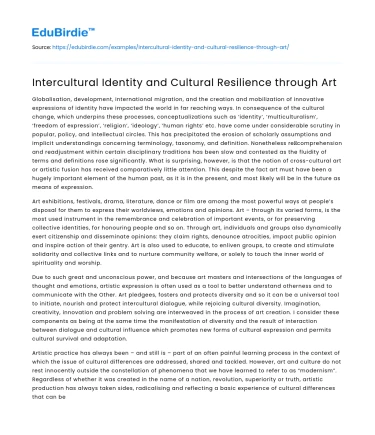Globalisation, development, international migration, and the creation and mobilization of innovative expressions of identity have impacted the world in far reaching ways. In consequence of the cultural change, which underpins these processes, conceptualizations such as ‘identity’, ‘multiculturalism’, ‘freedom of expression’, ‘religion’, ‘ideology’, ‘human rights’ etc. have come under considerable scrutiny in popular, policy, and intellectual circles. This has precipitated the erosion of scholarly assumptions and implicit understandings concerning terminology, taxonomy, and definition. Nonetheless re‐comprehension and readjustment within certain disciplinary traditions has been slow and contested as the fluidity of terms and definitions rose significantly. What is surprising, however, is that the notion of cross-cultural art or artistic fusion has received comparatively little attention. This despite the fact art must have been a hugely important element of the human past, as it is in the present, and most likely will be in the future as means of expression.
Art exhibitions, festivals, drama, literature, dance or film are among the most powerful ways at people’s disposal for them to express their worldviews, emotions and opinions. Art – through its varied forms, is the most used instrument in the remembrance and celebration of important events, or for preserving collective identities, for honouring people and so on. Through art, individuals and groups also dynamically exert citizenship and disseminate opinions: they claim rights, denounce atrocities, impact public opinion and inspire action of their gentry. Art is also used to educate, to enliven groups, to create and stimulate solidarity and collective links and to nurture community welfare, or solely to touch the inner world of spirituality and worship.
Save your time!
We can take care of your essay
- Proper editing and formatting
- Free revision, title page, and bibliography
- Flexible prices and money-back guarantee
Due to such great and unconscious power, and because art masters and intersections of the languages of thought and emotions, artistic expression is often used as a tool to better understand otherness and to communicate with the Other. Art pledgees, fosters and protects diversity and so it can be a universal tool to initiate, nourish and protect intercultural dialogue, while rejoicing cultural diversity. Imagination, creativity, innovation and problem solving are interweaved in the process of art creation. I consider these components as being at the same time the manifestation of diversity and the result of interaction between dialogue and cultural influence which promotes new forms of cultural expression and permits cultural survival and adaptation.
Artistic practice has always been – and still is – part of an often painful learning process in the context of which the issue of cultural differences are addressed, shared and tackled. However, art and culture do not rest innocently outside the constellation of phenomena that we have learned to refer to as “modernism”. Regardless of whether it was created in the name of a nation, revolution, superiority or truth, artistic production has always taken sides, radicalising and reflecting a basic experience of cultural differences that can be found in abundance in the history of Europe and beyond. In my paper, I shall refer to art as a manifestation of intentionality, personal will and social significance and conduct an analysis from the angle of its multiple impacts in cultural, political, economic, social, philosophical, or religious aspects of life in the public sphere. By further exploring the concepts of acculturation, cultural identity, cultural alteration and cultural adaptation through different examples from the history of art – and most especially focusing on the Modern and Postmodern artistic movements – I will try to show the pattern of the attained cultural resilience through the power of the artistic expression as a coping mechanism of the avant-garde movements to new realities.






 Stuck on your essay?
Stuck on your essay?

